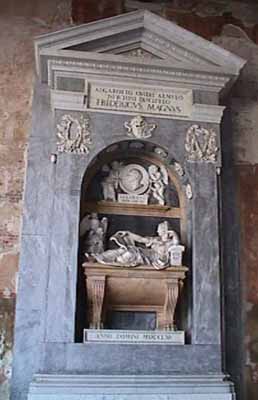- Francesco Algarotti
Infobox Person
name = PAGENAME |thumb
|thumb
image_size = 200px
caption = Tomb of Algarotti inCamposanto di Pisa
birth_name =
birth_date =11 December ,1712
birth_place =
death_date =3 May ,1764
death_place =
death_cause =
resting_place =
resting_place_coordinates =
residence =
nationality = Italian
other_names =
known_for =
education =
employer =
occupation =philosopher
home_town =
title =
salary =
networth =
height =
weight =
term =
predecessor =
successor =
party =
boards =
religion =
spouse =
partner =
children =
parents =
relatives =
website =
footnotes = Count Francesco Algarotti (11 December ,1712 –3 May ,1764 ) was an Italianphilosopher andart critic .He also completed engravings.He was born in
Venice to a rich merchant. He studied atRome for a year, and thenBologna , he studied natural sciences and mathematics. At age of twenty, he went toParis , where he became friendly withVoltaire and produced his "Neutonianismo per le dame", a work on optics. Voltaire called him his "cher cygne de Padoue" ("dear swan of Padua"). Two years later he was inLondon , where he was made a fellow of theRoyal Society , and became embroiled in a lively bisexual love-triangle with the politician John Hervey, and Lady Mary Wortley Montagu. Algarotti later dedicated six of the letters that made up his "Viaggi di Russia" to Hervey. Returning from a journey toRussia , he metFrederick the Great , who made him a Prussian count in 1740 and court chamberlain in 1747; they are said to have been lovers.Augustus III of Poland also honoured him with the title of councillor. In 1754, after seven years' residence partly inBerlin and partly inDresden , he returned toItaly , living at Venice and then atPisa , where he died. Frederick the Great erected to his memory a monument on theCampo Santo at Pisa. He was "one of the first "beaux esprits" of the age," a man of wide knowledge, a connoisseur in art and music, and the friend of most of the leading authors of his time.His chief work on art is the "Saggi sopra le belle arti" ("Essays on the Fine Arts"). Among his other works were "Poems", "Travels in Russia", "Essay on Painting", and "Correspondence".
He was one of the main "collectors" of art for
Augustus III of Poland 's collection inDresden . His choice of works reflects the encyclopedic interests of the Neoclassic age; he was uninterested in developing a single unitary stylistic collection, he envisioned a modern museum, a catalogue of styles from across the ages. For contemporary commissions, he wrote up a list for paintings he recommended commissioning, including to ask of history paintings from Tiepolo, Pittoni, andPiazzetta ; scenes with animals from Castiglione, andveduta with ruins from Pannini. He wanted "suggetti graziosi e leggeri" from Balestra, Boucher, andDonato Creti .Works
* [http://friedrich.uni-trier.de/oeuvres/18/ Correspondence with Frederick the Great]
References
*1911
*cite book | first= Francis|last= Haskell| year=1993| title= Patrons and Painters: Art and Society in Baroque Italy| chapter= Chapter 14 | editor= | others=1980 | pages= p 347-360 | publisher= Yale University Press| id= | url= | authorlink=
Wikimedia Foundation. 2010.
